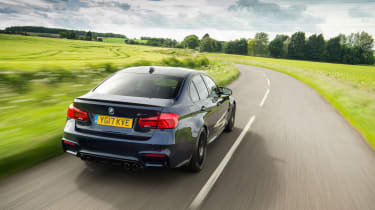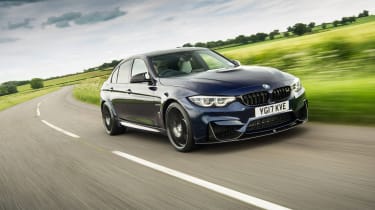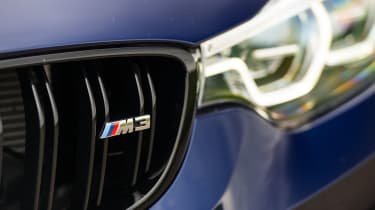F80 BMW M3 review (2014-2018)
The latest updates to this performance car icon have improved it greatly, it now has the composure to match its mighty performance
The BMW M3 has become a fundamental part of the performance car world since its introduction in 1988. Track days or a Nürburgring tourist lap wouldn’t be complete without at least one M3 of some generation slithering its way round the circuit. In the 32 years since the M3 lineage was founded, the car’s influence hasn’t waned much either. BMW’s creation remains a benchmark sports coupe, and saloon, that trades little of the base 3-series’ comfort and usability in delivering its exceptional driving dynamics.
When the current F80 model was released in 2014, it brought with it a larger saloon-only bodystyle (the coupe and cabriolet now moved to the less evocative M4 moniker), a turbocharged six-cylinder engine and more comfort and convenience features than ever before.
The performance and pace of the early versions of the F80 was never in doubt, but they weren’t particularly suited to the UK’s bumpy and undulating roads. Poor body control, particularly at the rear, made the car feel difficult to predict and trust, especially when the weather was anything other than bone dry.
Over the years, tweaks to the BMW’s chassis and drivetrain calibration helped, but it wasn’t until the M3 Competition version arrived that the F80 M3’s potential was finally realised. Despite the 19bhp power bump, the Competition’s tweaks were so successful that BMW eventually dropped the standard version, leaving just the Competition and the rare, expensive CS available when production came to an end in 2018.
More reviews
Group tests
In-depth reviews
Review
Reviews
- > Performance and 0-60 time – Massive torque has made the M3 an astonishingly fast car. It will go from 0-60mph in 4.1sec and onto 100mph in just 8.6sec.
- > Engine and gearbox – The omission of naturally aspirated motor might have upset M3 purists, but the F80 M3 has one of the most exciting and intense turbocharged engines on sale.
- > Ride and handling – The F80 might lack the finesse that the M3 has built its reputation on, but it’s still fast and fun to drive.
- > MPG and running costs summary – The turbocharged engine might look more economical on paper, but in reality it’s just as expensive to run as any performance car.
- > Interior and tech – The M3 uses the functional, but not particularly glamorous, interior from the 3-series. A sprinkling of carbonfibre is really the only difference.
- > Design – A bonnet bulge, flared arches and deep spoilers give the M3 a very aggressive look.
Prices, specs and rivals
In 2018, £59,905 was the entry price for the base car in standard trim equipped with a six-speed manual gearbox; specify the optional dual clutch transmission and BMW asked another £2,500 of you.
Competition Package trim cost a further £3,000, but its gentle power bump, bigger wheels, revised chassis and recalibrated LSD softened the sharp edges of the standard M3, improving the overall package beyond the very reasonable price hike. Many, if not all of the late-build M3s are Competition-spec though, and very few were ordered with the manual transmission. If you plan on taking your M3 on track, it’s worth finding an example with carbon ceramic brakes, although they’re also rare due to their £6250 premium.
The wait for the next-gen M3 won’t be too long though, with an all-new generation based on the current G20 3-series is expected later in 2020. We already know it’ll keep hold of a turbocharged in-line-six petrol engine, although it’ll be the new S58 unit found in the X3 M. M3s fitted with a manual transmission and rear-wheel drive are expected to be available, but most will combine an eight-speed ZF automatic gearbox and selectable all-wheel drive for the first time. It will finally match the Mercedes-AMG C63 and Alfa Romeo Giulia Quadrifoglio for power with 503bhp though.
Rivalling this next-gen M3 is Audi’s RS4 Avant, which does a great job of putting power to the tarmac, although its sterile, somewhat cold demeanor makes it more of a fast road car than a track hack. The RS5 Sportback is (meant to be) the RS4’s more stylish five-door hatchback variant, but its driving experience is not any sharper in reality, while the sloping roofline and hatchback body is less practical. The pair were also revised for 2020, and cost from around £64,000 and £70,000 for the RS4 and RS5 respectively.
Mercedes-AMG’s C63 S is a more powerful proposition, and like the Audi it lacks the final well-honed edge in terms of driver involvement. Its V8 is a whole lot more powerful with 503bhp though it’s a somewhat pricier £74,000. There’s also an optional estate bodystyle.
It’s the Italian in this equation that’s impossible to overlook though; Alfa Romeo’s Giulia Quadrifoglio is, quite literally, the BMW M3’s worst nightmare. Its more powerful, charismatic and effective twin-turbo 2.9-litre V6 engine matches the AMG with 503bhp, but is situated in a lighter and more focussed chassis. It’s agile yet confidence inspiring, playful yet composed, the Giulia Quadrifoglio was a shock to the system when it arrived in 2017, and one that really showed up the BMW M3’s 32-year domination of the sports saloon class







